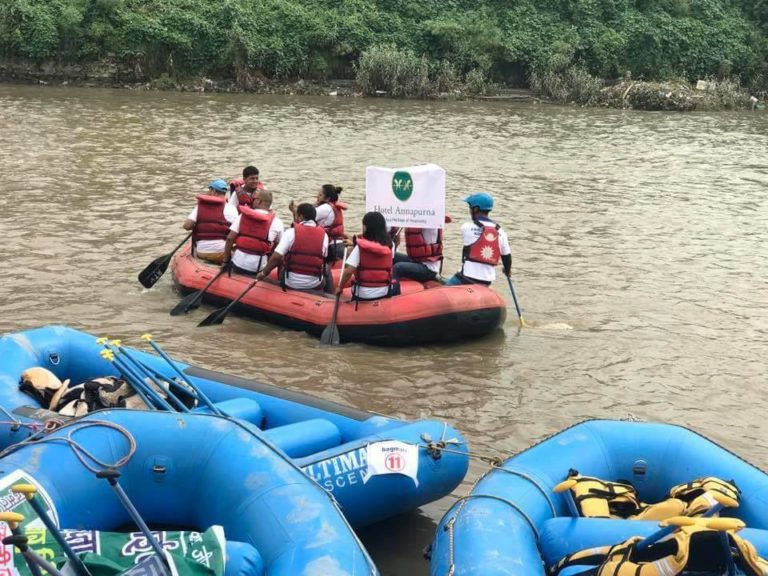Bagmati River Festival 2017 — Collaborating to Bring Relief to Flood Victims of Nepal
By: ajcarapella

By Sanu Maiya Maharjan, Friends of Bishnumati, Bagmati River Waterkeeper Affiliate
A festival with a purpose — Nepal Waterkeepers bring relief to victims of the floods that affected nearly half of the country’s districts.
On August 19, more than 7000 people gathered on the bank of the Bagmati River to celebrate the Bagmati River Festival 2017. The aim of this festival was to celebrate and conserve the sacred Bagmati River, to raise awareness about the degraded condition of the river and its tributaries within Kathmandu Valley, to notify change makers and locals of the conservation needs of rivers, and to pressure government authorities to revive the Bagmati to its original state. The festival was jointly organized by Nepal River Conservation Trust (NRCT), Bagmati River Waterkeeper and Friends’ Club Kopundole with support from many other organizations in Nepal.
The Bagmati River Festival was introduced in 2001 by NRCT along with the initiation of its Founder and President, Megh Ale, who shared a vision to see children and fish swimming together and pilgrims taking holy baths in the Bagmati. To achieve this vision, each year the festival creates a platform for all friends of the river, including government and non-government organizations, educational institutes, religious groups, children and all who have concern for the Bagmati to work together to save this river. The NRCT has been focusing on the plight of the Bagmati River for the past 16 years. They use the festival as an annual platform to highlight conservation issues surrounding the rivers of Nepal and as a time for all concerned parties to participate and present solutions.
This was the festival’s 17th year and included many activities like the Heritage Cycle rally to establish a bicycle lane on the Bagmati Corridor, the 223rd Bagmati Clean-up Campaign, a school art competition with the theme of “River Conservation and Our Responsibility,” rafting on the Bagmati River, and many more activities. What set this year apart from past events was the goal to support the victims of the devastating flood in the Terai region that occurred on August 13, 2017.

Due to the devastating floods in the last week of July, close to half of the country’s districts were affected, from which more than 120 people have died and more than 18,000 families have been forced to abandon their homes. The Bagmati Mega Clean-up Campaign, the Federation of Nepalese Chambers of Commerce and Industry (FNCCI), Bagmati River Festival Organizing Team, Karnali River Waterkeeper and Bagmati River Waterkeeper gathered to help the flood victims. In the initial stage, more than 15 rafts had been sent to the flood-affected districts to rescue people from the flood thanks to Karnali River Waterkeeper, Nepal Association of Rafting Agencies (NARA), Nepal Kayak and Canoe Club, Ultimate Descents Nepal and The Borderlands Resort and Hotel.
According to Umesh Bohora, Bagmati clean-up campaigner and coordinator for flood relief collection and distribution, “[As of August 29], relief supplies such as food, clothes, temporary shelter material, medicines, water, etc. have been sent to about 1000 families in the 20 flood affected districts (Rautahat, Saptari, Nawalparasi, Bardia and others) and 1,500,000 (USD$15000) has been sent with the help of different organizations and private sectors of Nepal.” He added that they will organize health camps in those districts as there are increased health issues associated with floods such as diarrhea, pneumonia and other viral and waterborne diseases.
To symbolize different groups coming together to protect the Bagmati River and the people of Nepal, Cultural Expert and Litterateur Hon’ble Satya Mohan Joshi inaugurated the event by pouring water from 17 major rivers of Nepal into the Bagmati. Joshi said at the ceremony, “The civilization of every country is linked with the major rivers, which is the same case with the Bagmati River in Nepal. We can conserve our ancient civilization and culture if we restore the river to its original pristine state.”
“The conservation of the Bagmati River is not only a single person’s responsibility, all the people must join together for this cause,” Ale, chair of the ceremony, said. “We need to organize this kind of festival frequently, which connects the people directly with the river and increases the love and affection towards the Bagmati River. Only then can we conserve and restore the Bagmati River to its original state.”
More than 250 individuals representing different stakeholders joined a rafting excursion from Kopundole to Sundari Ghat of the Lalitpur District during the festival and observed the condition of the Bagmati River first-hand. This gave an opportunity for stakeholders to see the current condition of the Bagmati River and realize the need to protect it.
The 2017 Bagmati River Festival brought thousands of participants together from across Nepal to commit to helping clean and keep the Bagmati River alive — while at the same time supporting the thousands of families devastated by the catastrophic flooding. Extreme weather events such as Hurricane Harvey in Texas and those occurring throughout South Asia this summer will only be exacerbated by climate change and are becoming the new normal. But through strong community engagement like the Bagmati River Festival, our waters and communities can become resilient.